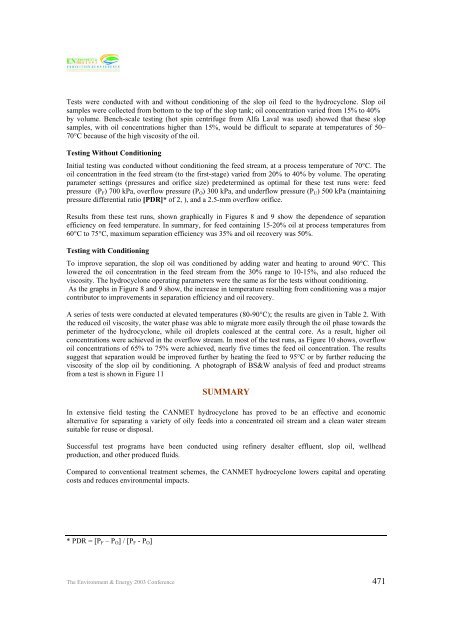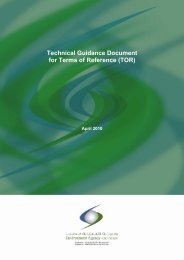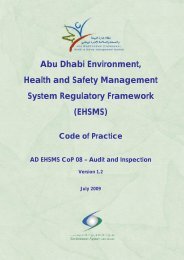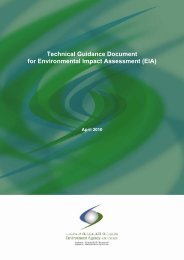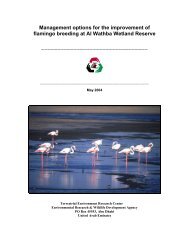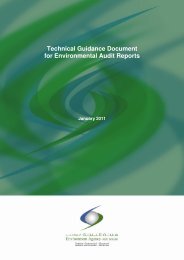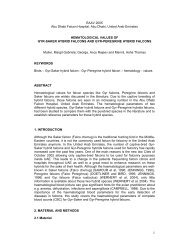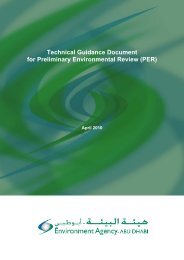APPLICATIONS OF THE <strong>CANMET</strong> HYDROCYCLONETREATMENT OF DESALTER EFFLUENTRefinery desalters generate significant volumes of oily effluents. Depending on <strong>the</strong> upstream processes and<strong>the</strong> initial feed, <strong>the</strong>se effluents may contain significant amounts of oil (up to 10% by volume) and solids (upto 5%), especially during desand operations. High oil contents reduce <strong>the</strong> separating ability of <strong>the</strong> skimtanks and significantly leng<strong>the</strong>n <strong>the</strong> residence time of <strong>the</strong> fluid in <strong>the</strong> tank. Typical retention time of skimtanks ranges from a few hours to a day. Hence, it is highly desirable to utilize a separation technology thatis able to efficiently and effectively separate this effluent, reducing <strong>the</strong> retention time and hence reducing<strong>the</strong> number of skim tanks required. With its low capital cost and virtually no maintenance costs, <strong>the</strong><strong>CANMET</strong> hydrocyclone stands out as <strong>the</strong> best solution to this problem.A period of successful field testing was conducted at <strong>the</strong> Husky Energy Lloydminster refinery prior to <strong>the</strong>installation of <strong>the</strong> commercial <strong>CANMET</strong> hydocyclone system. <strong>The</strong> results obtained from <strong>the</strong> field testingwere very encouraging, as a stream of clean water containing ppm levels of oil and <strong>the</strong> bulk of <strong>the</strong> solids(mostly clean with <strong>the</strong> oil coating stripped off) was produced. From observations of <strong>the</strong> underflow samplescollected, <strong>the</strong> solids settled in less than 30 minutes in most cases. Hence, it was anticipated that <strong>the</strong>underflow water could be separated in a significantly reduced period of time and would cause minimal orno problems when injected into disposal wells. As a result, a multi-hydrocyclone system with a capacity ofabout 1000 m3/d (shown in Figure 3) was constructed and installed at <strong>the</strong> Husky refinery. Figure 4 shows afront view of <strong>the</strong> open <strong>CANMET</strong> hydrocyclone vessel. <strong>The</strong> worker is installing a hydrocyclone unit.Excellent results were obtained after <strong>the</strong> installation of <strong>the</strong> multi-hydrocyclone system. Oil content analysesof feed, overflow, and underflow streams on various days are shown in Table 1. On some days, make-upwater was added to <strong>the</strong> effluent stream to meet <strong>the</strong> minimum processing capacity of <strong>the</strong> system. In anyevent, <strong>the</strong> multi-hydrocyclone unit can be set up <strong>for</strong> a lower processing capacity by replacing some of <strong>the</strong>hydrocyclone units with blanks. Figure 5 shows samples collected during normal desalter operation. <strong>The</strong>feed contained about 1% oil and 5.6% suspended solids. After <strong>the</strong> separation, <strong>the</strong> overflow contained about11% oil (with traces of solids remaining with <strong>the</strong> oil phase) and was free of settled solids. <strong>The</strong> underflowwas almost free of oil (on-site colour matching analysis showed oil concentration less than 100 ppm) andall of <strong>the</strong> solids reported with this stream. Figure 6 shows samples collected during <strong>the</strong> desanding phase ofoperation. This difficult-to-separate emulsion takes about 4–6 hours (and longer in some cases) to separatein a settling tank. <strong>The</strong> photograph was taken about 30 minutes after <strong>the</strong> three samples were collected. Noseparation could be observed in <strong>the</strong> feed sample. BS&W analysis showed that it contained about 7% oil and6% solids by volume. However, when this same feed was treated using <strong>the</strong> <strong>CANMET</strong> hydrocyclonesystem, it was separated into an oil-rich overflow containing about 35 vol% oil and traces of solids (about0.2%). Almost all of <strong>the</strong> solids in feed reported to <strong>the</strong> underflow stream with small amounts of residual oil.TREATMENT OF SLOP OILSlop oil is <strong>the</strong> fluid that is skimmed from deoiling skim tanks. It is a tight emulsion containing significantamounts of water, up to 90% by volume. Slop oil also contains “rag layer”, described by experienced oilfield workers as a solids-containing material found in <strong>the</strong> interphase region of <strong>the</strong> oil and water layers in askim tank. Rag layer is relatively viscous and is <strong>for</strong>med when residues from chemical injections in priorprocesses become attached to solids (fines), water, or oil droplets.A two-stage <strong>CANMET</strong> hydrocyclone system was set up at <strong>the</strong> client site to evaluate <strong>the</strong> per<strong>for</strong>mance of <strong>the</strong><strong>CANMET</strong> hydrocyclone to treat slop oil produced during <strong>the</strong> processing of wellhead production. <strong>The</strong> testloop, designed and assembled by <strong>the</strong> AST hydrocyclone team, is shown schematically in Figure 7.<strong>The</strong> Environment & Energy 2003 Conference 470
Tests were conducted with and without conditioning of <strong>the</strong> slop oil feed to <strong>the</strong> hydrocyclone. Slop oilsamples were collected from bottom to <strong>the</strong> top of <strong>the</strong> slop tank; oil concentration varied from 15% to 40%by volume. Bench-scale testing (hot spin centrifuge from Alfa Laval was used) showed that <strong>the</strong>se slopsamples, with oil concentrations higher than 15%, would be difficult to separate at temperatures of 50–70°C because of <strong>the</strong> high viscosity of <strong>the</strong> oil.Testing Without ConditioningInitial testing was conducted without conditioning <strong>the</strong> feed stream, at a process temperature of 70°C. <strong>The</strong>oil concentration in <strong>the</strong> feed stream (to <strong>the</strong> first-stage) varied from 20% to 40% by volume. <strong>The</strong> operatingparameter settings (pressures and orifice size) predetermined as optimal <strong>for</strong> <strong>the</strong>se test runs were: feedpressure (P F ) 700 kPa, overflow pressure (P O ) 300 kPa, and underflow pressure (P U ) 500 kPa (maintainingpressure differential ratio [PDR]* of 2, ), and a 2.5-mm overflow orifice.Results from <strong>the</strong>se test runs, shown graphically in Figures 8 and 9 show <strong>the</strong> dependence of separationefficiency on feed temperature. In summary, <strong>for</strong> feed containing 15-20% oil at process temperatures from60°C to 75°C, maximum separation efficiency was 35% and oil recovery was 50%.Testing with ConditioningTo improve separation, <strong>the</strong> slop oil was conditioned by adding water and heating to around 90°C. Thislowered <strong>the</strong> oil concentration in <strong>the</strong> feed stream from <strong>the</strong> 30% range to 10-15%, and also reduced <strong>the</strong>viscosity. <strong>The</strong> hydrocyclone operating parameters were <strong>the</strong> same as <strong>for</strong> <strong>the</strong> tests without conditioning.As <strong>the</strong> graphs in Figure 8 and 9 show, <strong>the</strong> increase in temperature resulting from conditioning was a majorcontributor to improvements in separation efficiency and oil recovery.A series of tests were conducted at elevated temperatures (80-90°C); <strong>the</strong> results are given in Table 2. With<strong>the</strong> reduced oil viscosity, <strong>the</strong> water phase was able to migrate more easily through <strong>the</strong> oil phase towards <strong>the</strong>perimeter of <strong>the</strong> hydrocyclone, while oil droplets coalesced at <strong>the</strong> central core. As a result, higher oilconcentrations were achieved in <strong>the</strong> overflow stream. In most of <strong>the</strong> test runs, as Figure 10 shows, overflowoil concentrations of 65% to 75% were achieved, nearly five times <strong>the</strong> feed oil concentration. <strong>The</strong> resultssuggest that separation would be improved fur<strong>the</strong>r by heating <strong>the</strong> feed to 95°C or by fur<strong>the</strong>r reducing <strong>the</strong>viscosity of <strong>the</strong> slop oil by conditioning. A photograph of BS&W analysis of feed and product streamsfrom a test is shown in Figure 11SUMMARYIn extensive field testing <strong>the</strong> <strong>CANMET</strong> hydrocyclone has proved to be an effective and economicalternative <strong>for</strong> separating a variety of oily feeds into a concentrated oil stream and a clean water streamsuitable <strong>for</strong> reuse or disposal.Successful test programs have been conducted using refinery desalter effluent, slop oil, wellheadproduction, and o<strong>the</strong>r produced fluids.Compared to conventional treatment schemes, <strong>the</strong> <strong>CANMET</strong> hydrocyclone lowers capital and operatingcosts and reduces environmental impacts.* PDR = [P F – P O ] / [P F - P O ]<strong>The</strong> Environment & Energy 2003 Conference 471


